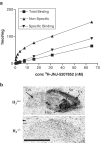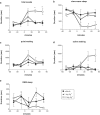Acute wake-promoting actions of JNJ-5207852, a novel, diamine-based H3 antagonist
- PMID: 15466448
- PMCID: PMC1575430
- DOI: 10.1038/sj.bjp.0705964
Acute wake-promoting actions of JNJ-5207852, a novel, diamine-based H3 antagonist
Erratum in
- Br J Pharmacol. 2005 Jan;144(1):145
Abstract
1 1-[4-(3-piperidin-1-yl-propoxy)-benzyl]-piperidine (JNJ-5207852) is a novel, non-imidazole histamine H3 receptor antagonist, with high affinity at the rat (pKi=8.9) and human (pKi=9.24) H3 receptor. JNJ-5207852 is selective for the H3 receptor, with negligible binding to other receptors, transporters and ion channels at 1 microm. 2 JNJ-5207852 readily penetrates the brain tissue after subcutaneous (s.c.) administration, as determined by ex vivo autoradiography (ED50 of 0.13 mg kg(-1) in mice). In vitro autoradiography with 3H-JNJ-5207852 in mouse brain slices shows a binding pattern identical to that of 3H-R-alpha-methylhistamine, with high specific binding in the cortex, striatum and hypothalamus. No specific binding of 3H-JNJ-5207852 was observed in brains of H3 receptor knockout mice. 3 In mice and rats, JNJ-5207852 (1-10 mg kg(-1) s.c.) increases time spent awake and decreases REM sleep and slow-wave sleep, but fails to have an effect on wakefulness or sleep in H3 receptor knockout mice. No rebound hypersomnolence, as measured by slow-wave delta power, is observed. The wake-promoting effects of this H3 receptor antagonist are not associated with hypermotility. 4 A 4-week daily treatment of mice with JNJ-5207852 (10 mg kg(-1) i.p.) did not lead to a change in body weight, possibly due to the compound being a neutral antagonist at the H3 receptor. 5 JNJ-5207852 is extensively absorbed after oral administration and reaches high brain levels. 6 The data indicate that JNJ-5207852 is a novel, potent and selective H3 antagonist with good in vitro and in vivo efficacy, and confirm the wake-promoting effects of H3 receptor antagonists.
Figures








References
-
- APELT J., LIGNEAU X., PERTZ H.H., ARRANG J.-M., GANELLIN C., SCHWARTZ J.-C., SCHUNACK W., STARK H. Development of a new class of nonimidazole histamine H3 receptor ligands with combined inhibitory histamine N-methyltransferase activity. Bioorg. Med. Chem. Lett. 2002;13:1767–1770. - PubMed
-
- APODACA R., DVORAK C.A., XIAO W., BARBIER A.J., BOGGS J.D., WILSON S.J., LOVENBERG T.W., CARRUTHERS N.I. A new class of diamine-based human histamine H3 receptor ligands: 4-(aminoalkoxy)-benzylamines. J. Med. Chem. 2003;46:3938–3944. - PubMed
-
- ARRANG J.M., GARBARG M., SCHWARTZ J.-C. Auto-inhibition of brain histamine release mediated by a novel class (H3) of histamine receptor. Nature (Lond.) 1983;302:832–837. - PubMed
-
- ARRANG J.M., GARBARG M., SCHWARTZ J.-C. Autoinhibition of histamine synthesis mediated by presynaptic H3 receptors. Neuroscience. 1987;23:149–157. - PubMed
Publication types
MeSH terms
Substances
Grants and funding
LinkOut - more resources
Full Text Sources
Other Literature Sources
Chemical Information
Medical

